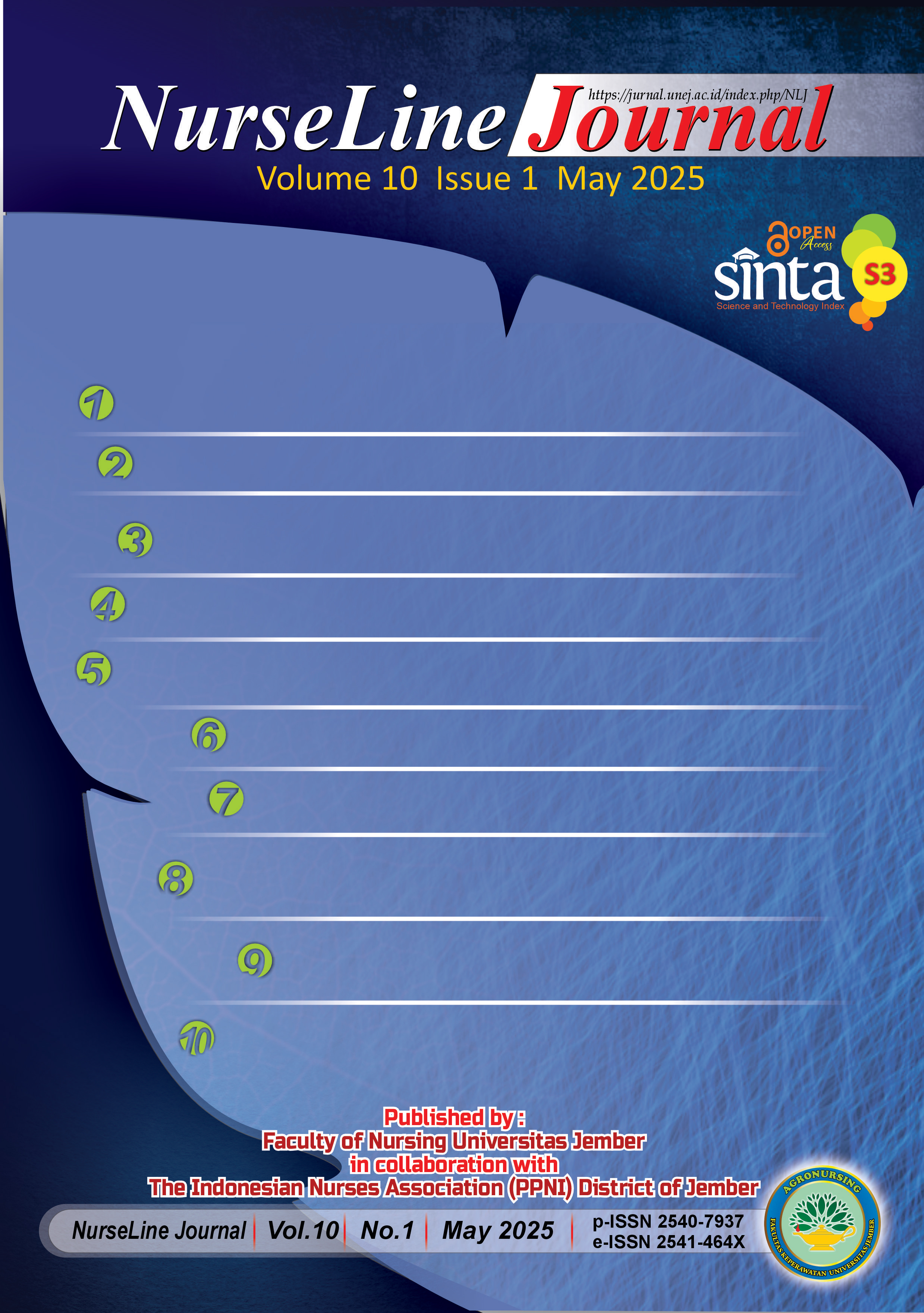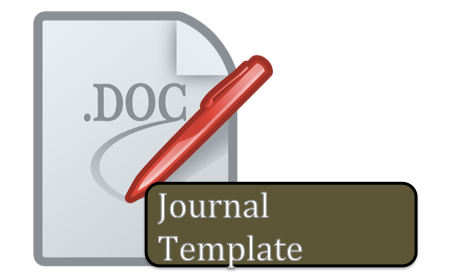Exploring The Quality Of Life Phenomenon Among Patients With Long Covid Syndrome
DOI:
https://doi.org/10.19184/nlj.v10i1.53694Keywords:
Long COVID Syndrome, physical health, quality of lifeAbstract
Background: Long COVID Syndrome (LCS) refers to persistence of symptoms beyond acute phase of COVID-19 infection. These prolonged symptoms may affect various aspects of health, particularly survivors' quality of life. However, research on this issue in rural settings remains limited. Objective: Study aimed to determine the relationship between the symptoms of Long COVID Syndrome and the quality of life of COVID-19 survivors in Ledug Village. Methods: Study used a quantitative study with a cross-sectional design involving 50 participants who were selected using total sampling. Data were collected using the symptom checklist for long COVID-19 based on the World Health Organization (WHO) and the WHOQOL-BREF questionnaire. Data analysis was performed using Spearman's rank correlation test. Results: The most respondents (48%) reported only one persistent symptom, mainly fatigue. Fatigue was often accompanied by shortness of breath and chest pain. Conclusion: Overall, QoL was rated good across psychological, social, and environmental domains. No significant correlation was found between the number of symptoms and overall QoL. However, a weak but significant association existed with physical health (p=0.009, r=0.36). The number of Long COVID symptoms is significantly associated with lower physical quality of life among survivors. Future efforts should focus on community-based rehabilitation programs to improve survivors' well-being.
Downloads
References
Asadi-Pooya, A. A., Akbari, A., Emami, A., Lotfi, M., Rostamihosseinkhani, M., Nemati, H., Barzegar, Z., Kabiri, M., Zeraatpisheh, Z., Fajroud-Kouhanjani, M., Jafari, A., Sasannia, S., Ashrafi, S., Nazeri, M., Nasiri, S., & Shahisavandi, M. (2021). Long COVID syndrome‐associated brain fog. 94(3), 979–984. https://doi.org/https://doi.org/10.1002/jmv.27404
Ballhausen, S., Ruß, A.-K., Lieb, W., Horn, A., Krist, L., Fricke, J., Scheibenbogen, C., Rabe, K. F., Maetzler, W., Maetzler, C., Laudien, M., Frank, D., Heyckendorf, J., Miljukov, O., Haeusler, K. G., Mokthari, N. E. El, Witzenrath, M., Vehreschild, J. J., Appel, K. S., … Bahmer, T. (2025). Subdomains of Post-COVID-Syndrome (PCS)-A Population-Based Study.
Carfì, A., Bernabei, R., & Landi, F. (2020). Persistent Symptoms in Patients After Acute COVID-19. JAMA, 324(6), 603. https://doi.org/10.1001/jama.2020.12603
Davis, H. E., Assaf, G. S., McCorkell, L., Wei, H., Low, R. J., Re’em, Y., Redfield, S., Austin, J. P., & Akrami, A. (2021). Characterizing long COVID in an international cohort: 7 months of symptoms and their impact. EClinicalMedicine, 38, 101019. https://doi.org/10.1016/j.eclinm.2021.101019
Devie, I. G. A. J. A., Suarningsih, N. K. A., Rahajeng, I. M., & Widyanthari, D. M. (2022). Gambaran Post-Acute Covid-19 Syndrome Pada Pasien Pasca Terinfeksi Coronavirus Disease 2019 I. Community of Publishing in Nursing (COPING), 10(3), 326–332.
Fernández-de-las-Peñas, C., Martín-Guerrero, J. D., Cancela-Cilleruelo, I., Moro-López-Menchero, P., Rodríguez-Jiménez, J., & Pellicer-Valero, O. J. (2022). Exploring the trajectory recovery curve of the number of post-COVID Symptoms: The LONG-COVID-EXP-CM Multicenter Study. International Journal of Infectious Diseases, 117, 201–203. https://doi.org/10.1016/j.ijid.2022.02.010
Galanis, P., Katsiroumpa, A., Vraka, I., Kosiara, K., Siskou, O., Konstantakopoulou, O., Katsoulas, T., Gallos, P., & Kaitelidou, D. (2023). Resilience and social support improve mental health and quality of life in patients with post-COVID-19 syndrome. https://doi.org/10.1101/2023.02.07.23285620
Gascon, M., Triguero-Mas, M., Martínez, D., Dadvand, P., Rojas-Rueda, D., Plasència, A., & Nieuwenhuijsen, M. J. (2016). Residential green spaces and mortality: A systematic review. Environment International, 86, 60–67. https://doi.org/10.1016/j.envint.2015.10.013
Hanley, A. W., & Garland, E. L. (2017). The Mindful Personality: a Meta-analysis from a Cybernetic Perspective. Mindfulness, 8(6), 1456–1470. https://doi.org/10.1007/s12671-017-0736-8
Huang, F., Sun, W., Zhang, L., Lu, H., & Chen, W. (2022). Depressive symptoms mediate COVID-associated stigma and quality of life: Stigma instrument validation and path analysis. Journal of Affective Disorders, 297, 269–275. https://doi.org/10.1016/j.jad.2021.10.043
Huang, Y., & Zhao, N. (2020). Generalized anxiety disorder, depressive symptoms, and sleep quality during COVID-19 outbreak in China: a web-based cross-sectional survey. Psychiatry Research, 288, 112954. https://doi.org/10.1016/j.psychres.2020.112954
Iskandarsyah, A., de Klerk, C., Suardi, D. R., Soemitro, M. P., Sadarjoen, S. S., & Passchier, J. (2014). Psychosocial and cultural reasons for delay in seeking help and nonadherence to treatment in Indonesian women with breast cancer: A qualitative study. Health Psychology, 33(3), 214–221. https://doi.org/10.1037/a0031060
Lopez, S. J., & Snyder, C. R. (2004). Positive psychological assessment: A handbook of models and measures. American Psychological Association.
Ministry of Health of the Republic of Indonesia. (2022). COVID-19 Statistics Indonesia.
Nalbandian, A., Sehgal, K., Gupta, A., Madhavan, M. V., McGroder, C., Stevens, J. S., Cook, J. R., Nordvig, A. S., Shalev, D., Sehrawat, T. S., Ahluwalia, N., Bikdeli, B., Dietz, D., Der-Nigoghossian, C., Liyanage-Don, N., Rosner, G. F., Bernstein, E. J., Mohan, S., Beckley, A. A., … Wan, E. Y. (2021). Post-acute COVID-19 syndrome. Nature Medicine, 27(4), 601–615. https://doi.org/10.1038/s41591-021-01283-z
Pham, A., Smith, J., Card, K. G., Byers, K. A., & Khor, E. (2024). Exploring social determinants of health and their impacts on self-reported quality of life in long COVID-19 patients. Scientific Reports, 14(1), 30410. https://doi.org/10.1038/s41598-024-81275-4
Puntmann, V. O., Carerj, M. L., Wieters, I., Fahim, M., Arendt, C., Hoffmann, J., Shchendrygina, A., Escher, F., Vasa-Nicotera, M., Zeiher, A. M., Vehreschild, M., & Nagel, E. (2020). Outcomes of Cardiovascular Magnetic Resonance Imaging in Patients Recently Recovered From Coronavirus Disease 2019 (COVID-19). JAMA Cardiology, 5(11), 1265. https://doi.org/10.1001/jamacardio.2020.3557
Purba, F. D., Hunfeld, J. A. M., Iskandarsyah, A., Fitriana, T. S., Sadarjoen, S. S., Passchier, J., & Busschbach, J. J. V. (2018). Quality of life of the Indonesian general population: Test-retest reliability and population norms of the EQ-5D-5L and WHOQOL-BREF. PLOS ONE, 13(5), e0197098. https://doi.org/10.1371/journal.pone.0197098
Sudre, C. H., Murray, B., Varsavsky, T., Graham, M. S., Penfold, R. S., Bowyer, R. C., Pujol, J. C., Klaser, K., Antonelli, M., Canas, L. S., Molteni, E., Modat, M., Jorge Cardoso, M., May, A., Ganesh, S., Davies, R., Nguyen, L. H., Drew, D. A., Astley, C. M., … Steves, C. J. (2021). Attributes and predictors of long COVID. Nature Medicine, 27(4), 626–631. https://doi.org/10.1038/s41591-021-01292-y
Susanto, A. D., Isbaniah, F., Pratomo, I. P., Antariksa, B., Samoedro, E., Taufik, M., Harinda, F., & Nurwidya, F. (2022). Clinical characteristics and quality of life of persistent symptoms of COVID-19 syndrome in Indonesia. GERMS, 12(1), 158–169.
Tamboeo, G., Waani, J. O., & Tilaar, S. (2016). HASIL PENELITIAN DAMPAK SOSIAL DARI POLA PERUMAHAN PERMATA ASRI PINELENG.
Townsend, L., Dowds, J., O’Brien, K., Sheill, G., Dyer, A. H., O’Kelly, B., Hynes, J. P., Mooney, A., Dunne, J., Ni Cheallaigh, C., O’Farrelly, C., Bourke, N. M., Conlon, N., Martin-Loeches, I., Bergin, C., Nadarajan, P., & Bannan, C. (2021). Persistent Poor Health after COVID-19 Is Not Associated with Respiratory Complications or Initial Disease Severity. Annals of the American Thoracic Society, 18(6), 997–1003. https://doi.org/10.1513/AnnalsATS.202009-1175OC
Vindegaard, N., & Benros, M. E. (2020). COVID-19 pandemic and mental health consequences: Systematic review of the current evidence. Brain, Behavior, and Immunity, 89, 531–542. https://doi.org/10.1016/j.bbi.2020.05.048
Visco, V., Vitale, C., Rispoli, A., Izzo, C., Virtuoso, N., Ferruzzi, G. J., Santopietro, M., Melfi, A., Rusciano, M. R., Maglio, A., Di Pietro, P., Carrizzo, A., Galasso, G., Vatrella, A., Vecchione, C., & Ciccarelli, M. (2022). Post-COVID-19 Syndrome: Involvement and Interactions between Respiratory, Cardiovascular, and Nervous Systems. Journal of Clinical Medicine, 11(3). https://doi.org/10.3390/jcm11030524
WHO. (2012). WHOQOL: measuring quality of life [serial online].
WHO. (2020). WHO Coronavirus Disease (COVID-19) Dashboard Data last updated: 2020/12/5, 3:02pm CET. https://covid19.who.int/?gclid=CjwKCAiAn7L-BRBbEiwAl9UtkAlOBO-wX0XnQyk8dMfsA_-2NIQljux0boYUK-dZ-UPW-OnhGKp9DBoC1LoQAvD_BwE
World Health Organisation. (2021). A clinical case definition of post-COVID-19 condition by a Delphi consensus.
World Health Organization. (2022). Coronavirus disease (COVID-19).
Downloads
Published
Issue
Section
License
Copyright (c) 2025 NurseLine Journal

This work is licensed under a Creative Commons Attribution-ShareAlike 4.0 International License.








